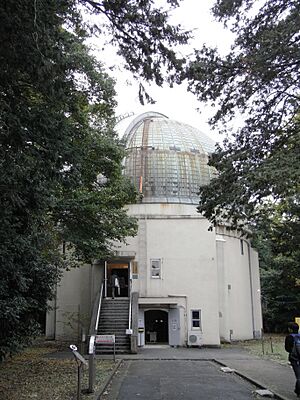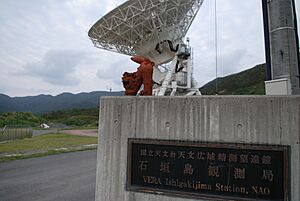National Astronomical Observatory of Japan facts for kids

The National Astronomical Observatory of Japan (国立天文台, kokuritsu tenmondai), or NAOJ for short, is a major Japanese organization for studying space. It has several observatories and research centers in Japan, and also operates powerful telescopes in Hawaii and Chile.
NAOJ was formed in 1988 when three different astronomy groups decided to join forces. These were the Tokyo Astronomical Observatory from the University of Tokyo, the International Latitude Observatory of Mizusawa, and part of the Research Institute of Atmospherics from Nagoya University. By working together, they could make even bigger discoveries.
In 2004, NAOJ became part of a larger group called the National Institutes of Natural Sciences (NINS). This helps scientists from different fields share ideas and work on projects together.
Contents
NAOJ's Observatories and Centers
NAOJ has many special places where scientists use telescopes and other tools to explore the universe. Each location focuses on different types of space research.
Mitaka Campus in Tokyo
The main headquarters of NAOJ is in Mitaka, Tokyo. This campus is the nerve center for all of NAOJ's work. It's home to:
- The Astronomy Data Center, where all the information from the telescopes is stored and studied.
- The Advanced Technology Center, where new tools and technologies for telescopes are invented.
- Telescopes for watching the Sun, like the Solar Flare Telescope and the Sunspot Telescope.
- The TAMA 300 detector, which was built to search for gravitational waves, which are like ripples in space.
- Historic telescopes that are now part of a museum, showing how astronomy has changed over the years.
Nobeyama Radio Observatory
Located in the mountains of Minamimaki, Nagano, this observatory uses radio telescopes to see parts of the universe that are invisible to regular telescopes. Its main instrument is a huge 45-meter radio telescope that studies things like distant galaxies and the birth of stars.
Mizusawa VLBI Observatory
This observatory in Ōshū, Iwate, is part of a project called VERA. It uses several radio telescopes across Japan that work together as one giant telescope. This helps scientists create incredibly detailed images of space. The Mizusawa site also has a museum dedicated to a famous scientist, Dr. Kimura.
The VERA Project Telescopes
VERA stands for VLBI Exploration of Radio Astrometry. It uses four 20-meter radio telescopes located far apart from each other to measure distances in our galaxy with amazing accuracy. The four stations are:
- Mizusawa Station in Iwate
- Ogasawara Station on Ogasawara island
- Iriki Station in Iriki
- Ishigakijima Station on Ishigaki island
Other Major Facilities in Japan
- KAGRA Telescope: Hidden deep inside a mountain in Hida, KAGRA is a special observatory designed to detect gravitational waves.
- Ishigakijima Observatory: Located on Ishigaki island, this observatory has a telescope named Murikabushi, which is used to study stars and planets.
International Observatories
NAOJ also works with other countries to run some of the world's best telescopes.
- Hawaii Observatory: On top of the Mauna Kea volcano in Hawaii, NAOJ operates the powerful Subaru Telescope. This 8.2-meter telescope can capture amazing images of faraway galaxies.
- Chile Observatory: In the dry Atacama Desert of Chile, NAOJ is a key partner in the Atacama Large Millimeter/submillimeter Array (ALMA). ALMA is a huge collection of radio telescopes that work together to study the cold, dark parts of the universe where stars and planets are born.
Important Space Missions
NAOJ is involved in many exciting space projects. These missions use satellites and telescopes to explore everything from our own Moon to the most distant galaxies. Some of these projects include:
- ALMA: A giant radio telescope array in Chile that studies the birth of stars and galaxies.
- SELENE: A mission that orbited the Moon to create a detailed map of its surface.
- Hinode: A satellite that stares at the Sun to help us understand its powerful flares and magnetic fields.
- SPICA (satellite): A planned space telescope that will use infrared light to see through cosmic dust clouds.
- JASMINE: A small satellite designed to map the stars in our Milky Way galaxy with high precision.
See also
 In Spanish: Observatorio Astronómico Nacional de Japón para niños
In Spanish: Observatorio Astronómico Nacional de Japón para niños
- List of astronomical observatories
- National Institutes of Natural Sciences, Japan
- Yūko Kakazu




